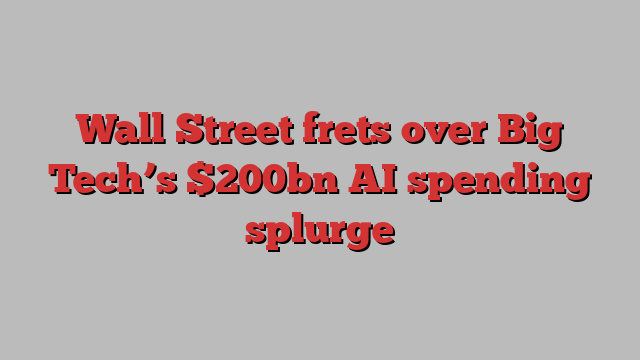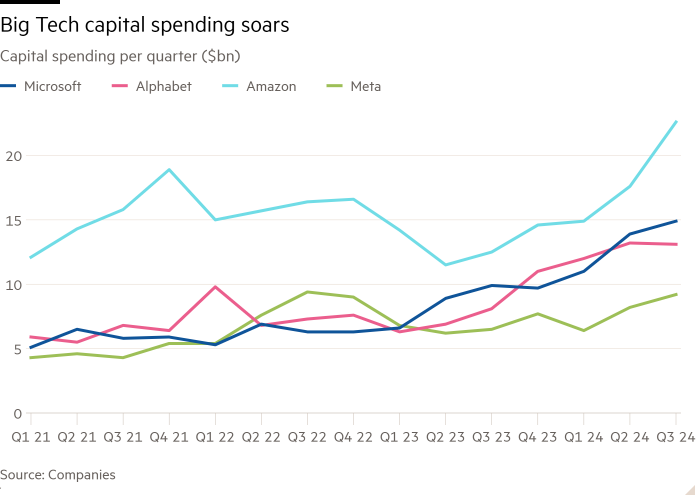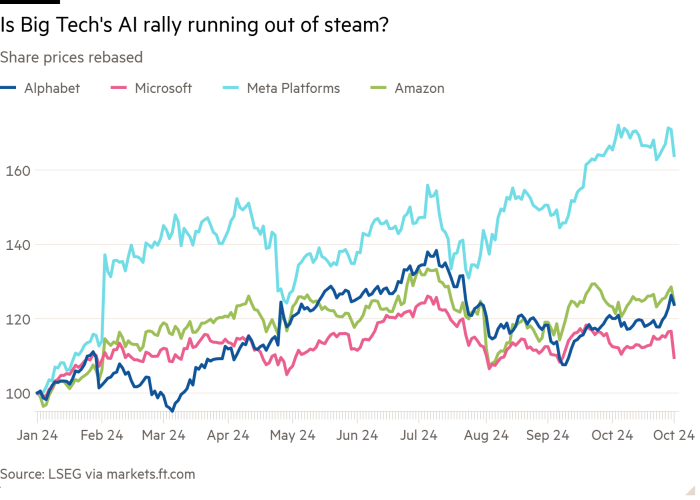
Big Tech’s capital spending is on track to surpass $200bn this year and rise even further in 2025, as anxiety grows on Wall Street about the returns on soaring investment in artificial intelligence.
The four biggest US internet groups — Microsoft, Meta, Amazon and Google’s parent Alphabet — this week offered investors brief glimpses into the benefits they are seeing from their headlong rush into generative AI, arguing that it was boosting the performance of core services and helping to hold down operating costs.
But the stock market suffered a spasm on Thursday as investors looked past the imprecise benefits to focus instead on another big — and very measurable — jump in spending on chips and data centre infrastructure, as the AI race accelerates.
Capital expenditure at the four biggest hyperscalers grew more than 62 per cent on the year before, to about $60bn during the quarter, according to this week’s financial reports. Meta and Amazon were among those to point to further increases in spending next year.
Analysts at Citi forecast that the quartet’s total capital spending will hit $209bn this year, up 42 per cent on 2023. Citi estimates that data centres account for about 80 per cent of that total.
“What is the real benefit?” said Jim Tierney, a growth stock investor at AllianceBernstein, voicing a common concern. “All of these companies are spending a huge amount of money,” he added, with a resulting hit to profit margins that would become “more noticeable in 2025”.

One sign that demand for generative AI was starting to lift Big Tech’s growth rates came from the accelerating growth in the cloud divisions at Microsoft and Google.
But the optimism quickly dissipated when Microsoft went on to warn that cloud growth would slip back this quarter, largely because of supply constraints. Meanwhile, cloud market leader Amazon Web Services failed to hit the most optimistic hopes for an acceleration in its own growth, even as it lifted investors’ spirits with unexpectedly strong profit margins.
Companies that peppered their earnings calls this week with anecdotal and mostly vague assurances about AI returns included Alphabet, which said the new generative AI features in its search engine were increasing engagement and boosting usage. It also said a quarter of the software it produced was now written by AI.
Despite this, the growth in Google’ search volumes declined from the preceding quarter, said Tierney, raising a question about how strong the AI effect had been.
However, Microsoft said its revenue from AI was on the brink of hitting an annualised $10bn, reaching that milestone faster than any other business in its history. It also said that Copilot — an AI feature for which it charges a monthly fee of $30 per user — had experienced “the fastest growth of a new suite” yet seen in its M365 productivity software.
The $10bn figure was a rare disclosure of a hard revenue number and serves as an early proof-point of the real benefits that could start to flow from generative AI, said Brent Thill, an analyst at Jefferies.
But few other software companies have revealed anything about the effects of AI on their revenue, he added, leaving the stock market to fret. “It’s murky. And investors are freaking out about the costs,” Thill said.

For its part, Meta told investors that AI had boosted returns from its advertising and improved engagement among users, while AWS said its “multibillion-dollar” AI business was growing at a rate of more than 100 per cent.
If anecdotes like this were encouraging but fuzzy, the rapidly rising spending on new data centres and equipment for AI was all too clear.
Facing a grilling from investors, executives at several companies claimed the massive increase in facilities to handle AI was closely tied to demand, and that capital efficiency would improve as the business increased in scale.
Executives at Amazon and Microsoft drew comparisons with the early days of the cloud computing business, when building and equipping fleets of data centres also caused spending to soar.
There are strong advanced buying signals from customers that make it possible to time investment spending closely to actual demand, said Amazon’s chief executive Andy Jassy. Microsoft’s chief financial officer Amy Hood said about half of the software company’s capital spending goes on server purchases, which could be timed closely to increases in demand.
Despite the claims of investment discipline, investors were left with the reality that the higher spending will hit Big Tech’s income statements next year, even as any revenue benefits are uncertain.
Meta, for instance, warned that 2025 would see “significant acceleration in infrastructure expense growth”, as its new fleet of data centres lead to higher depreciation charges and operating costs.
Changes in depreciation policies at Microsoft, Alphabet and Amazon in recent years will lessen the pain. All three have extended the useful lives of their data centre gear for accounting purposes, reducing the amount of depreciation they need to report each year.
Amazon said extending the useful lives of its servers by a year had lifted the profit margin in its cloud division by 2 percentage points in the latest quarter — the second time it has taken this step in two years.
But even after the moves to push depreciation charges further into the future, the pressure on margins from soaring spending on AI will be hard to avoid.
After a powerful two-year rally as earnings expectations for Big Tech have ratcheted steadily higher, this could indicate a turning point. The tech-heavy Nasdaq Composite closed 2.8 per cent lower on Thursday, with Microsoft, Meta and AI chipmaker Nvidia together shedding more than $400bn in value.
“Investors are left asking if the ‘beat and raise’ era [in quarterly earnings announcements] is over,” said Tierney. If so, the convulsion that passed through the market on Thursday could be a sign of rockier times ahead.